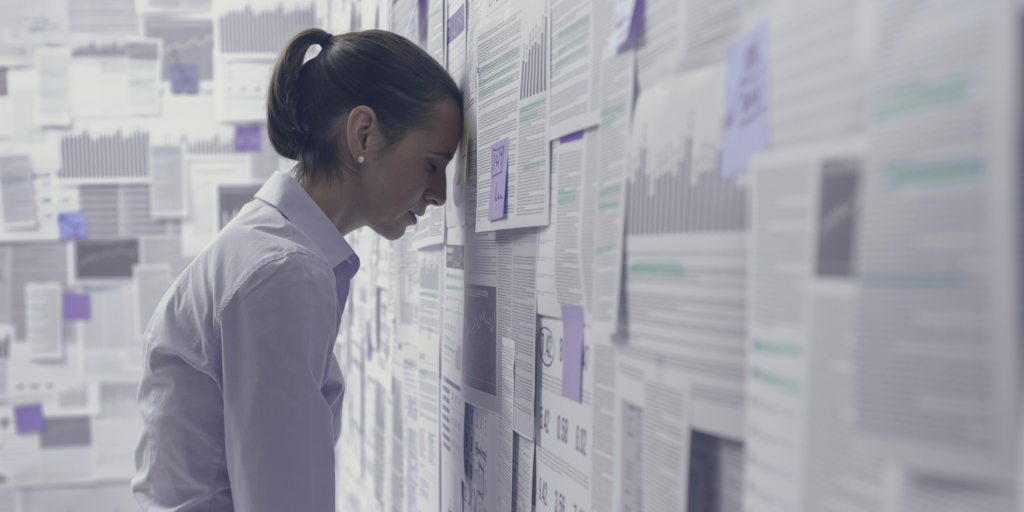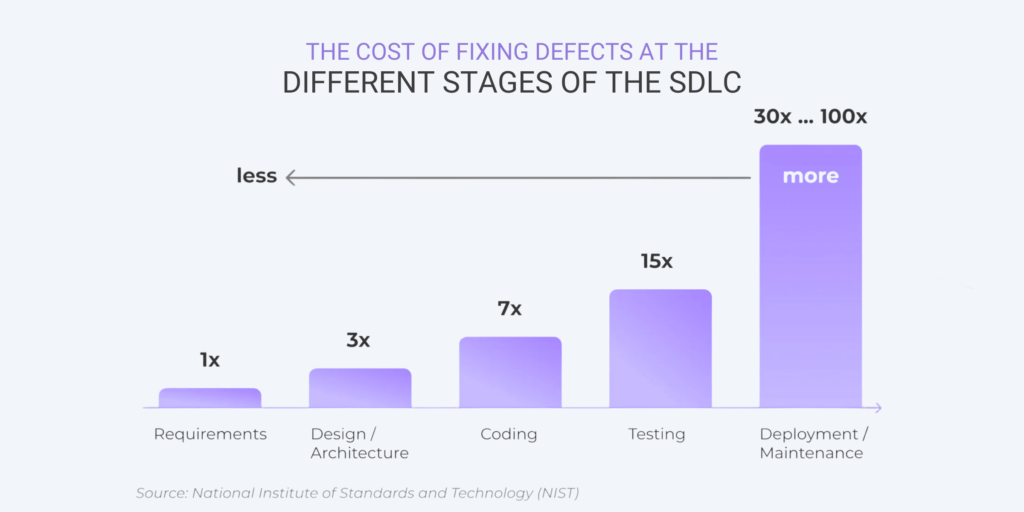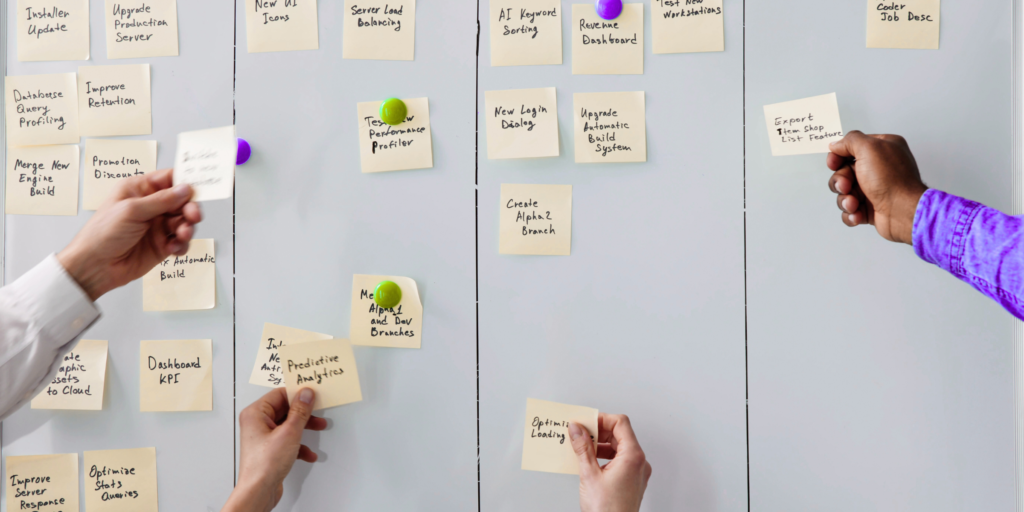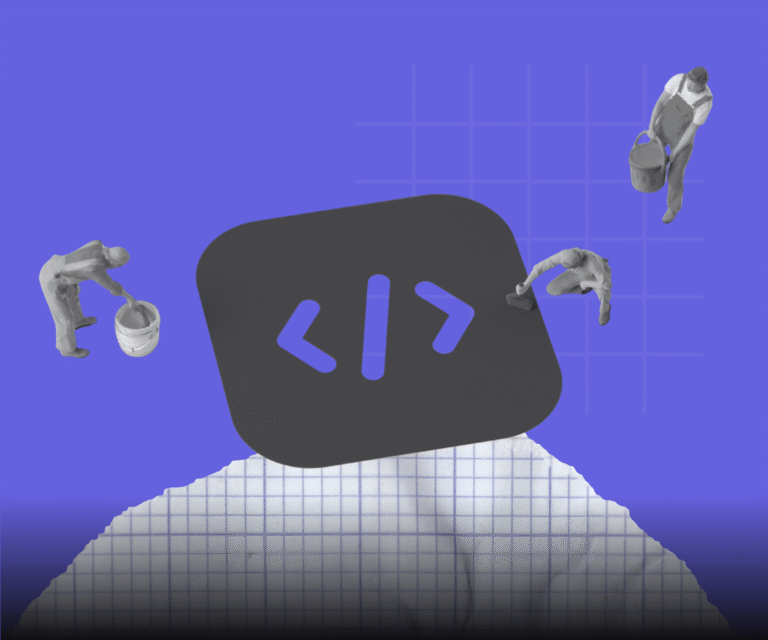The Discovery Phase: The Foundation That Makes Software Projects Successful
Have you ever watched a software project launch with a lot of enthusiasm, only to collapse just a few months later? Maybe the final product worked perfectly, technically speaking, but no one wanted to use it. Or perhaps expenses spiraled so far out of control that the project was terminated entirely. So why does it happen? Why do 70% of software projects fail to meet their original goals? The issue often lies in skipping one key step: the discovery phase.
A solid discovery phase is crucial for software development and provides the foundation to build on. Discovery work determines how your whole project will unfold. When companies skip proper discovery and rush into development, they often end up with solutions that don’t solve the real problems, leading to wasted resources and implementation failures. These projects regularly miss critical business objectives and user needs, resulting in costly post-launch corrections.
A well-executed discovery phase brings everyone together, confirms the real requirements, and establishes a clear direction for the project. Organizations that do discovery right from the start consistently outperform others: they reduce development costs by up to 40%, achieve higher user satisfaction scores, and need significantly fewer post-launch modifications.
This article dives into why and how a strategic discovery phase makes such a difference in project success. We’ll look at effective methodologies and see their actual impact on the software development process.
What You Get You Skip Discovery: Failed Projects and Unhappy Users

When organizations bypass the discovery phase or treat it superficially, they’re setting themselves up for trouble. According to Freshcode research, a clear understanding of goals and requirements during the discovery phase helps development teams estimate time and budget much more precisely, reducing the risk of missed deadlines by 75%. The overall cost savings can exceed 50%. Skipping this phase often leads to unclear requirements and misaligned goals. They end up dealing with scope creep, budget overruns, and products that fail to meet user expectations.
Think about what happens when you start a software project without involving users or stakeholders early on. Development teams waste time and money building features that users either don’t want or can’t figure out how to use. This not only wastes resources but also undermines confidence in the final product. Proper discovery work eliminates these risks by building a strong foundation. Projects that take discovery seriously create solutions that are both valuable and easy to use, built on real user insights and aligned business goals. This saves resources and produces software people genuinely want to use.

The Numbers Don’t Lie: Why Discovery Pays Off
Skipping the discovery phase doesn’t just create problems; it kills projects. The Standish Group’s CHAOS 2020 study shows that 50% of IT projects exceed their original budgets and deadlines, and 19% get canceled entirely. Poor research and requirement gathering during discovery is a major reason why this happens. In other words, that’s not just bad luck, it’s bad planning.
A well-defined discovery process enables organizations to identify potential roadblocks early, thoroughly test their assumptions, and manage risks before they escalate into costly problems. In contrast, teams that bypass this step often face unexpected challenges during development, which force reactive decisions, increase expenses, and throw off schedules. Companies that prioritize discovery see measurable improvements in project predictability, efficiency, and overall success rates. They avoid the expensive rework and failures that derail other projects and get much better odds of delivering something that works.
The Value Proposition of a Structured Discovery Phase
A structured discovery phase is more than basic preparation; it gives your project direction from the start. It helps you spot risks early, get everyone on the same page, and make sure you’re solving the right problems. Addressing critical questions early on minimizes uncertainties and provides a roadmap for the development process. It makes teamwork better, and the whole build is way more focused.
One major advantage of a well-executed discovery phase is how it aligns what users need with business goals. Through methods like stakeholder interviews, user research, and requirement prioritization, teams can build solutions that resonate with users while achieving organizational objectives. Additionally, a structured discovery phase enhances collaboration among cross-functional teams, fostering a unified approach to problem-solving. This alignment is crucial for navigating the complexities of modern software development and ensuring that projects deliver value to both users and businesses.

A solid discovery phase doesn’t happen by accident. It takes the right mix of people working together. Business analysts, UX researchers, UI designers, and stakeholders each bring a unique perspective. Business experts help define what matters most, designers make sure the experience feels right, and researchers figure out what users need. When these roles collaborate early on, vague ideas turn into clear, grounded plans that make sense for both the business and the people using the product.
Business analysts: Turning ideas into plans that work
Business analysts (BAs) are the bridge between business goals and technical execution. They take broad goals and turn them into clear, detailed requirements that everyone can work from. By talking to stakeholders, asking the right questions, and digging into the bigger strategy, they make sure nothing important gets lost in translation. Their real skill is making sense of messy challenges and turning them into a roadmap the team can follow.
UX researchers: Figuring out what users need

UX researchers focus on understanding how people think, where they struggle, and what helps them finish tasks. They run interviews, short surveys, and quick usability sessions; the stories and metrics they capture guide the team toward features that feel natural instead of confusing. Grounding design decisions in that evidence pays off fast: McKinsey’s 2023 study on experience-led growth reports that organisations using deep customer-insight programs lift satisfaction by 20–30 percent and get solid revenue gains.
UI designers: Turning ideas into real user experiences
UI designers take all the research and planning and shape it into something people can use. They focus on layouts, visuals, and interactions that feel natural and easy to navigate. Using design systems and prototyping tools, they build early versions of the product that let the team see how everything will look and work. Their job is to make sure the interface feels smooth, intuitive, and matches what users expect, before any code gets written.
Stakeholder involvement: Who’s at the table and why it matters
Discovery works best when the right people are involved from the start. Stakeholders bring the business context, user knowledge, and technical perspective that help shape the project. This group usually includes decision-makers, end-users, and technical leads. Keeping them engaged throughout helps surface challenges early, clarify goals, and build a shared understanding of what the project should deliver. When everyone feels heard and aligned, the project has a much better shot at staying on track and meeting real needs.
The Discovery Process Framework
The discovery process framework lays the groundwork for a successful project by systematically addressing user needs, business goals, and technical constraints. This framework ensures that every aspect of the project is thoroughly explored and validated before development begins, reducing risks and increasing the likelihood of success. By following a structured approach, teams can identify potential challenges early, align stakeholders, and create a clear roadmap for implementation. Here’s how the key steps come together to make that happen.
Initial Stakeholder Interviews and Alignment
The discovery process begins with stakeholder interviews to align on objectives, expectations, and constraints. These interviews provide valuable insights into the project’s goals from a business, technical, and user perspective. Engaging with key stakeholders early ensures that their priorities are understood and incorporated into the project plan. The alignment achieved during this stage lays a foundation for collaboration, minimizing conflicts and ensuring a shared vision across all parties involved.
For example, teams might use semi-structured interviews to gather detailed feedback from department heads, end-users, and technical leads. This approach fosters open communication and helps identify potential risks or misalignments that could impact the project’s success. The outcomes of these interviews are documented and form the basis for the next stages of the discovery process.
User Research Methodologies
Once everyone is aligned on the project goals, the next step is understanding the end-users. This part of the discovery phase focuses on uncovering behaviors, challenges, and expectations. Teams rely on a variety of methods, including surveys, usability tests, and contextual inquiries, to gather both qualitative and quantitative insights.
Contextual inquiries are especially helpful because they allow researchers to observe users in their own environments. According to Maze’s 2025 User Research Report, organizations that embed research into product development report significant gains: 83% see better usability, 63% higher customer satisfaction, and 34% improved retention. And when research informs broader business strategy, the benefits multiply with 2.7x better outcomes, 5x stronger brand perception, and 3.6x more active users compared to those that rarely apply user insights.
Requirements Gathering Techniques
Requirements gathering is one of the most important parts of the discovery phase. It turns what you’ve learned from stakeholders and users into a clear list of what the product needs to do. This stage helps bridge the gap between ideas and execution.
Teams use methods like workshops, brainstorming sessions, and affinity mapping to sort through and prioritize information. These tools make sure nothing essential gets lost and that the final list of requirements makes sense for both the business and the users.
In a typical workshop, stakeholders and team members work together to define the project’s goals and what needs to be delivered. These sessions help avoid confusion later by building shared understanding from the start. What comes out of this process becomes the foundation for how the product is designed and built.
Iterative Design and Validation Approaches
The last stage of discovery focuses on testing ideas early and refining them through real feedback. Teams begin with simple wireframes or low-fidelity mockups to explore concepts and check whether they’re on the right track. These early designs help spark conversations and surface any issues before too much time is spent building.
Over time, these rough sketches evolve into more polished prototypes that closely reflect how the final product will look and behave. Sharing them with stakeholders and users allows the team to spot friction points and make changes while things are still easy to adjust.
This process of testing, refining, and repeating helps ensure the final design not only looks good but also works well in practice. It keeps the project grounded in real needs and avoids last-minute surprises.
BA & UX Integration Strategies
The integration of Business Analysis (BA) and User Experience (UX) roles forms the backbone of a successful discovery phase. By blending analytical rigor with user-centric design, organizations can ensure that their projects are both strategically aligned and deeply resonant with user expectations. This section explores key strategies for achieving great collaboration between these essential functions.
Collaborative Workshop Techniques

Collaborative workshops are one of the best ways to bring business analysts and UX designers together. Sessions like design sprints or requirements discussions help everyone share ideas and get aligned early. They’re great for clearing up confusion and making sure everyone is working toward the same goals. A typical design sprint might include group brainstorming, sketching out wireframes, and deciding together which features matter most. This kind of hands-on, team-based work keeps things moving and makes sure every voice is heard during discovery.
Shared Documentation Practices
Keeping everyone on the same page is one of the toughest parts of getting BA and UX teams to work together. That’s why shared documentation is so important. Tools like Notion or Confluence let teams store everything in one place, user personas, workflows, feedback, and requirements, so nothing gets lost and everyone can stay up to date. When teams have a single, organized space to collaborate, communication improves, and it’s much easier to avoid confusion later in the project.
From User Stories to Design Requirements
Turning user stories into real design decisions is where business analysis and UX come together. While business analysts capture big-picture goals and technical needs, UX designers take that input and figure out how it works on screen. Joint review sessions help both sides stay aligned. For instance, a simple story like “users need quick access to account settings” might turn into a wireframe showing exactly where that button lives, how it looks, and what happens when it’s clicked. This back-and-forth helps make sure business priorities and user experience stay connected throughout the project.
Conflict Resolution When Business and User Needs Diverge
Sometimes, business goals and user needs pull in different directions. That’s normal and fixable. What matters is getting everyone talking early and often. Teams can use tools like impact mapping or prioritization exercises to weigh trade-offs and decide what really matters. Say the business wants to collect more data, but it clutters the user flow. Instead of forcing it through, the team might find a cleaner way to meet both goals. Writing down the decisions and the reasons behind them helps keep things transparent and makes sure everyone stays on the same page.
Deliverables That Drive Development Success
The discovery phase produces more than just insights. It results in practical materials that guide the entire development process. These deliverables help turn research and planning into action. When done well, they give everyone involved a clear direction, reduce confusion, and keep the project aligned with its original goals. They also make it easier to spot gaps or issues early, before they become costly problems later on.
Functional Requirements Documentation
Functional requirements documentation is a cornerstone deliverable of the discovery phase. This document outlines the specific functionalities and features that the software must include to meet user and business needs. By capturing these details early, teams can mitigate the risk of scope creep and ensure that development efforts remain aligned with project goals.
For example, functional requirements documentation might specify the behavior of a search feature, detailing how users can interact with it and the expected outcomes. This level of detail helps bridge the gap between abstract ideas and concrete implementation, providing developers with clear guidance on what needs to be built.
User Journey Maps and Personas
User journey maps and personas help teams stay grounded in real user needs throughout the project. Instead of guessing what users want, you can see how they interact with your product and what matters to them.
A journey map shows the path someone takes to complete a task, step by step. It helps teams spot friction points, find ways to simplify actions, and uncover opportunities to improve the overall experience. Personas, meanwhile, are fictional characters based on real research. They capture typical user behavior, goals, frustrations, and what motivates them.
When used together, these tools give everyone on the team a shared understanding of who they’re building for and why. The result is software that feels more thoughtful, more useful, and a lot more enjoyable to use.
Interactive Prototypes
Interactive prototypes take your early ideas and turn them into something people can see and click. They help the team and stakeholders experience the product’s flow before any code is written.
Instead of debating abstract features, you can walk through a realistic version of the user journey, like adding items to a cart or checking out. This hands-on approach makes it easier to spot what works and what doesn’t.
Testing these clickable mockups early helps avoid costly changes later. It’s a practical way to make sure the final product feels right for real users.
Design Systems and Component Libraries
Design systems and component libraries help teams stay consistent and efficient. A design system lays out the rules, styles, and assets that shape how the software should look and feel. The component library includes reusable pieces like buttons, menus, and input fields that can be used across different parts of the product.
These tools make collaboration easier. Designers and developers work from the same playbook, which reduces misunderstandings and saves time. The end result is a smoother process and a more polished user experience.
Case Study: Discovery Success Story
This case study shows how proper discovery can completely change a product’s direction for the better. Spotify thought they knew what their users wanted, but when they did the proper research, they found something totally different. The result was one of their most successful features that users absolutely love.
Client’s Original Assumptions vs. Discovered Reality
When Spotify started working on what would eventually become “Discover Weekly,” they had a pretty straightforward assumption. Initially, Spotify assumed that users primarily wanted broad access to trending playlists and popular music. The team believed that surfacing the most-played songs globally would keep users engaged.
However, during the discovery phase, through a combination of user interviews, behavioral analytics, and A/B testing, Spotify uncovered a different reality. Users valued personalized recommendations much more than generic trending charts. Many users felt overwhelmed by choice and struggled to find new music that matched their unique tastes. This insight fundamentally shifted the project’s direction.
Rather than focusing solely on popularity metrics, Spotify developed a machine-learning-driven recommendation system that analyzed individual listening habits. This discovery led to the creation of the “Discover Weekly” playlist, automatically generating a unique playlist for each user every Monday, based on their music preferences.
Key Insights That Changed the Project Direction
Spotify’s discovery research provided several game-changing insights:
- Users wanted personalization, not just popularity. Many listeners preferred suggestions tailored to their specific habits over general top-chart playlists.
- Engagement increased when users felt their preferences were understood. Early tests showed that personalized recommendations led to longer listening sessions and higher retention rates.
- Seamless discovery was key. Users enjoyed the experience of stumbling upon new music that felt like a natural extension of their existing preferences, rather than needing to search manually.
By integrating collaborative filtering algorithms, deep learning models, and natural language processing, Spotify was able to analyze user behaviors, match them with similar listeners, and predict songs that would resonate. The impact was significant: Spotify saw a 40% increase in user engagement and a sharp rise in subscriber retention.
Development Efficiency Improvements
The insights gained during discovery allowed Spotify to streamline development and avoid costly missteps. Instead of iterating on an assumption-driven feature (global top charts), the team focused on building a robust AI-driven recommendation system that aligned with user needs.
By validating concepts early, Spotify avoided:
- Wasting resources on developing a one-size-fits-all playlist model
- Reworking features that did not resonate with their audience
- Delaying launch due to unclear objectives
Having a clear product roadmap based on real user behavior enabled the engineering team to build, test, and refine the system without scope creep or unnecessary pivots.
User Satisfaction and Business Impact
The launch of Discover Weekly was one of Spotify’s most successful product rollouts:
- Within 10 weeks, over 40 million users had engaged with the feature.
- Listeners spent an average of 2.3x more time on the platform.
- A significant increase in premium subscriptions was directly linked to Discover Weekly’s value in surfacing new, beloved music.
The takeaway? Discovery isn’t just a preliminary step; it’s an investment in long-term success. Without deep user research, Spotify might have wasted time building a generic feature. Instead, by understanding what users truly wanted, they delivered a highly successful product that reinforced user loyalty, increased engagement, and drove revenue growth.
Conclusion
The discovery phase is more than just a preliminary step in software development; it is the foundation upon which successful projects are built. By investing time and resources in this critical phase, organizations can ensure that their software not only meets but exceeds user and business expectations. The strategies and deliverables discussed throughout this article underscore the transformative power of a well-executed discovery phase.
As we conclude, let us explore how a robust discovery process drives measurable outcomes, gains organizational support, and seamlessly integrates into agile methodologies.
ROI of Proper Discovery
Investing in the discovery phase yields significant returns on investment (ROI) by minimizing risks, reducing rework, and ensuring alignment between project objectives and outcomes. A comprehensive discovery process identifies potential challenges early, enabling the team to address them proactively rather than reactively. This results in cost savings and improved efficiency during subsequent development stages.
According to ProdPad, incorporating structured discovery can dramatically reduce wasted development time and help avoid costly detours by validating ideas before they reach the build stage. Teams that prioritize discovery avoid pursuing features that don’t meet user needs or business goals, ultimately delivering more value with fewer resources. These insights give stakeholders the clarity to make confident, data-informed decisions and keep projects moving in the right direction.
Tips for Getting Organizational Buy-In
Securing organizational buy-in for the discovery phase is crucial for its success. One effective approach is to communicate the tangible benefits of discovery to key stakeholders. Highlighting real-world examples and data-driven outcomes can help build a compelling case for its importance.
Another strategy is to involve stakeholders early in the discovery process. By participating in activities such as workshops and brainstorming sessions, they gain firsthand experience of the value that discovery brings. This involvement fosters a sense of ownership and commitment, making it easier to secure their support for the necessary time and resources.
Additionally, aligning the objectives of the discovery phase with broader organizational goals can enhance buy-in. When stakeholders see how discovery contributes to achieving strategic priorities, they are more likely to endorse and champion the process.
Implementing Discovery in Agile Environments
Integrating the discovery phase into agile methodologies requires careful planning and adaptation. Agile environments prioritize flexibility and iteration, which align well with the principles of discovery. However, the challenge lies in balancing the need for upfront research with the iterative nature of agile development.
One effective approach is to treat the discovery phase as an ongoing process rather than a one-time event. By conducting iterative discovery sprints, teams can continuously refine their understanding of user needs and project requirements. For example, in our article on implementing machine learning for predictive maintenance, we discuss how early discovery helped align predictive algorithms with real-world maintenance workflows, showing how discovery can fuel both innovation and efficiency throughout the development lifecycle.
Collaboration between discovery and development teams is another critical factor. Regular communication and shared tools, such as Kanban boards and collaborative documentation platforms, enable seamless integration and alignment. For example, user stories and journey maps created during discovery can be directly incorporated into sprint planning and execution, ensuring a smooth transition from research to development.
By implementing these strategies, organizations can harness the benefits of discovery while maintaining the agility and adaptability that define modern software development practices.
We’ve helped companies implement machine learning for predictive maintenance across different industries. Want to see how we’d approach your specific maintenance challenges? Let’s talk!


